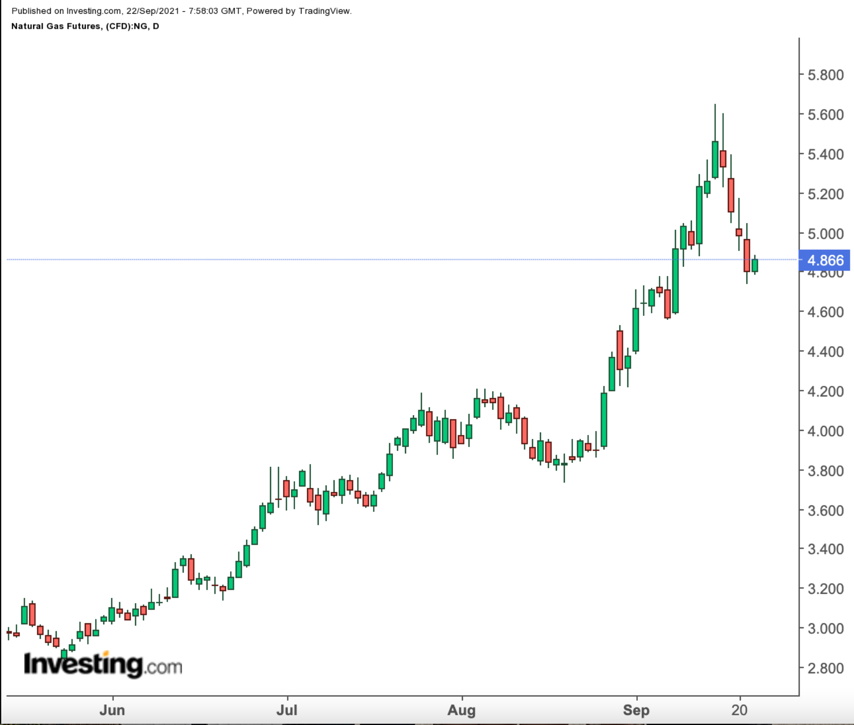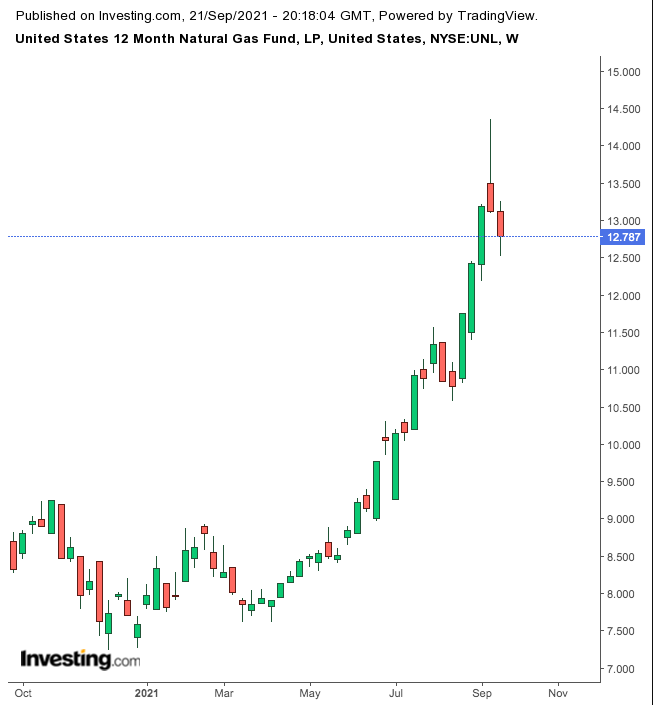Late September means the start of fall and cooler weather in the Northern Hemisphere. As winter approaches, high natural gas prices have been making headlines, especially in the UK and the European Union where demand driven by economic recovery is colliding with supply constraints.

On Sept. 20, the price of the commodity was initially above $5 per mmBtu (or million metric British thermal units). Then, during the course of the trading day, profit-taking pushed the price toward the current level of about $4.88. Year-to-date, natural gas returned more than 80%, and 74% in the last 12 months.
Over the past decade, the US has surpassed Russia and become the top producer of natural gas worldwide. Iran, Qatar, China, Canada, and Norway are next in line. On the consumption side of the equation, we see the US, Russia, China, Iran, and Japan.
McKinsey & Company’s recent research on gas and liquefied natural gas (LNG) markets points out:
“While we saw high levels of volatility in 2020, the outlook for gas and LNG shows strong growth, resilience… Asia will continue to drive global LNG demand growth.”
Today, we offer a list of several energy companies that would give investors exposure to gas in portfolios and discuss a natural gas exchange-traded product (ETP).
Leading Gas Stocks
Natural gas bulls follow a number of energy shares, including:
- Antero Resources (NYSE:AR) — up 151% YTD;
- Cabot Oil & Gas Corporation (NYSE:COG) — up 19% YTD;
- Cheniere Energy (NYSE:LNG) — up 42% YTD;
- EQT (NYSE:EQT) — up 47% YTD;
- Kinder Morgan (NYSE:KMI) — up 15% YTD;
- Northern Oil & Gas (NYSE:NOG) — up 96% YTD;
- Royal Dutch Shell (NYSE:RDSa — up 13% YTD;
- Southwestern Energy (NYSE:SWN) — up 62% YTD;
- Tellurian (NASDAQ:TELL) — up 146% YTD.
As the numbers above show, the returns in these stocks so far this year have not been similar to the return seen in the commodity. With that information, here's an exchange-traded product (ETP) that natural gas bulls might want to research further:
United States 12 Month Natural Gas Fund
Current Price: $12.80
52-Week Range: $7.24 - $14.36
Expense Ratio: 0.90% per year
The United States 12 Month Natural Gas Fund (NYSE:UNL) tracks the price of natural gas delivered at the Henry Hub in Louisiana. It began trading in November 2009. With $14.2 million under management, it is a small commodity fund.

UNL holds 12 benchmark futures contracts extending out to the next 12 months. Most futures contracts typically expire on a rolling monthly basis. The daily price moves in UNL reflect the changes in those futures contracts.
In other words, the ETP holds and rolls exposure across 12 separate futures contracts over 12 months. As a result, UNL is different from the United States Natural Gas Fund (NYSE:UNG), another natural gas fund.
In the case of UNG, fund managers buy and roll exposure in the front futures contract, which is traded on the NYMEX. Around two weeks before expiration, UNG rolls its exposure into the second-month contract.
Rolling over is a concept we previously discussed. It affects returns of such commodity funds. In most cases, rolling over creates losses. Therefore, ETPs, like UNL to UNG, are typically more appropriate as short-term trading instruments. This means they would not be held as part of a long-term portfolio.
If we had to compare UNL with UNG, its sister fund, we see that over a 52-week period the returns have been higher for UNL:
- UNL: up 48.8% in the past 12 months;
- UNG: up 41.6% in the past 12 months.
Traders who hold UNL have less exposure (i.e., 1/12th) to the front futures contract because they hold further out along the futures curve. As a result, their exposure to the roll yield is less.
Therefore, if we had to choose between UNL and UNG, we’d go with UNL. However, we have to once again emphasize that such commodity ETPs that utilize futures contracts are not suitable for buy-and-hold investors.
Given the recent run up in price, natural gas bulls might want to wait for a pullback of about 3%-5% before starting a new position. However, we expect natural gas prices to remain strong in the long run. Flat supplies and rising demand are likely to dominate news headlines in many countries.
Finally, investors who do not want to commit capital into commodity funds, but instead want to include exchange-traded funds (ETFs) that hold natural gas stocks might want to keep the following funds on their radar:
- First Trust Natural Gas ETF (NYSE:FCG) — up 65.5% YTD (Note: this ETF holds more oil stocks than natural gas names.);
- Invesco DWA Energy Momentum ETF (NASDAQ:PXI) — up 50.1% YTD;
- SPDR® S&P Oil & Gas Exploration & Production ETF (NYSE:XOP) — up 44.3% YTD;
- VanEck Vectors Unconventional Oil & Gas ETF (NYSE:FRAK) — up 58.8% YTD.
